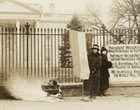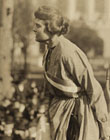Suffragettes
– Artist’s Website –
Penn[sylvania] on the picket line– 1917. Women–Suffrage
1918-1920: The Fight for Approval of the Suffrage Amendment
In January 1918, President Wilson announced his support for the suffrage amendment, and the U.S. House of Representatives passed the proposed amendment. Despite support by prominent political leaders, including former President Theodore Roosevelt, conservative senators stood firm in opposition to the extension of suffrage. The National Woman’s Party redoubled their efforts to affect the vote in the Senate.
In a lobbying attempt, the National Woman’s Party gathered signatures on a petition supporting passage of a suffrage amendment and delivered it to Senator Jones of New Mexico, Chairman of the Suffrage Committee. Of the 96 senators representing the 48 states in the union, 62 supported ratification in October, two votes short of the two-thirds majority needed to send the amendment to the states for ratification. Women who demonstrated outside the Senate Office Building were arrested.
photo of watchfire at White House

Party watchfires burn outside the White House
Although President Wilson had expressed his support for the suffrage amendment, the NWF wanted him to be more active in urging passage of the amendment. President Wilson left Washington in December 1918 to attend the international peace conference in Versailles. In January 1919, the National Woman’s Party devised a new tactic to pressure for the adoption of a suffrage amendment to the Constitution. Members would gather with copies of the president’s speeches on issues relating to democracy and burn them in urns outside public buildings, including the White House. With a banner implying that the resident was a hypocrite, women outside the White House burned a speech Wilson had given on his grand tour of Europe. These “Watchfires of Freedom” resulted in more arrests and often provoked counter demonstrations.
Forced to move from the gates outside the White House, activists moved across the street to Lafayette Square and continued their demonstrations, including burning presidential speeches, while Wilson was at the peace negotiations.
What was the purpose of the Watchfire demonstrations?
As with some banners carried by pickets, the Watchfire demonstrations focused on President Wilson’s own words. What is the effect of using an opponent’s words to support a position? Can you think of other cases in which activists have used this strategy?
On Wilson’s return from Europe, he was to deliver a speech at the Metropolitan Opera House in New York. Doris Stephens, Legislative Chairman of the National Woman’s Party, and several other picketers managed to cross the police barricade. The demonstrators were arrested after being attacked by onlookers.
Prison special photo of Lucy Branham

Lucy Branham in Occoquan prison dress.
To keep public attention on the Senate, the NWP devised a new strategy—the “Prison Special.” Women who had served sentences for demonstrating donned their prison uniforms and set out on a coast-to-coast tour in February and March 1919, making speeches in support of a suffrage amendment.
Republicans had gained control of the Congress in the off-year election. In May 1919 the House of Representatives again passed a suffrage amendment. By June the Senate, now with a Republican majority, passed the amendment by a vote of 66 to 30, two more than the two-thirds required. The job was far from complete, however, as 36 states (three-fourths of the 48 states) were needed to ratify the amendment.
How effective do you think the “Prison Special” tactic was in marshaling public support?
Why did demonstrators shift their focus away from President Wilson and the Democratic politicians to Republicans in 1919?
Why was it so difficult to gain Senate approval of the suffrage amendment?
Which states do you think were most likely to support passage of the amendment? Which states were least likely to agree?

Alice Paul, National Chairman of the Woman’s Party, unfurled the ratification banner from Suffrage headquarters.
Within days of Senate passage, Wisconsin became the first state to ratify the Susan B. Anthony Amendment. As each state voted for ratification, women sewed a star in the NWP Ratification Flag. Suffrage activists who had worked for years were invited to witness governors signing the amendment after it passed their state’s legislature.
When the amendment had not been ratified by 36 states at the time of the June 1920 conventions of the two political parties, the NWF sent delegations to both, lobbying states that had not yet ratified the amendment and asking the parties to insert a plank into their platforms supporting suffrage. The Democrats agreed to the suffrage plank, but the Republicans did not, and the NWP picketed the convention.
The struggle finally came down to Tennessee. Alice Paul and a delegation from the NWP consulted with Governor Cox on the chances of passage by the Tennessee legislature in the upcoming ratification vote. Upon receiving word that Tennessee had voted to ratify, Paul unfurled the ratification flag with 36 stars from the balcony of the National Woman’s Party in Washington.
——————————————————————-
The Suffragettes wanted the right for women to vote. The move for women to have the vote had really started in 1897 when Millicent Fawcett founded theNational Union of Women’s Suffrage. “Suffrage” means the right to vote and that is what women wanted – hence its inclusion in Fawcett’s title.






